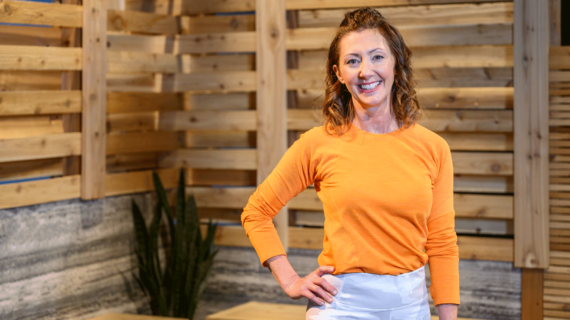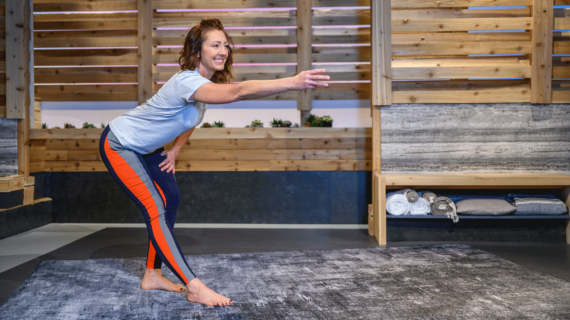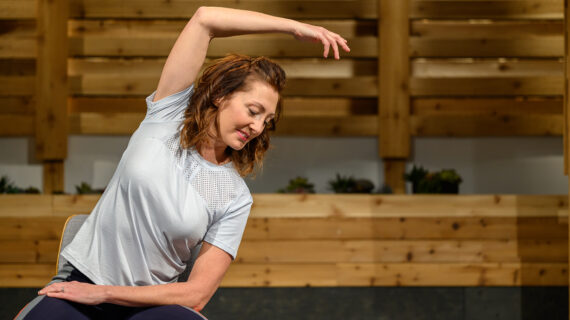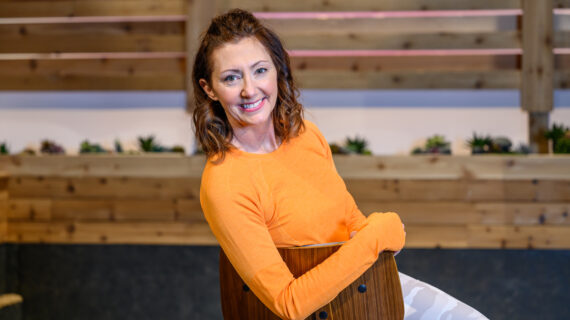– Welcome everyone, to Wednesday Nite at the Lab. I’m Tom Zinnen, I work here at the UW-Madison Biotechnology Center, I also work for UW Extension, Cooperative Extension, and on behalf of those folks and our other co-organizers, Wisconsin Public Television, the Wisconsin Alumni Association, and the UW-Madison Science Alliance, thanks again for coming to Wednesday Nite at the Lab. We do this every Wednesday night, 50 times a year. Tonight, it’s my pleasure to introduce to you Doug Reinemann, he’s a professor in biological systems engineering here at UW-Madison, and he is also associate dean for Extension and Outreach in the College of Agricultural and Life Sciences. He was born in Frankfurt, Germany, and grew up in Sheboygan, Wisconsin. And he graduated from Sheboygan North High School, is there a Sheboygan South?
– There is.
– Whoo.
– Yes, there is.
– All right, I feel the rivalry. And then he came here to UW-Madison to get his bachelor’s degree in ag engineering. He also got his master’s degree here in ag engineering. This was before the name of the department changed to biological systems engineering. Then he went to Cornell University in New York and got his PhD in ag engineering, and then he went to work for USAID, which is the United States Agency for International Development, and he worked in Islamabad, Pakistan. In 1990, he came back to UW-Madison to be on the faculty, which is where he’s been ever since. Tonight, he’s going to talk about one of the more important things if you’re a dairy farmer or if you work on a farm. Cows like to be milked, they like to be milked twice a day, sometimes three times a day, and that’s what we call work. And you’re an engineer, you get to use your ingenuity to make that less work, more fun, better quality milk, happier cows, and all that good stuff. Doug’s going to talk with us about Milking Machines: The First 100 Years, From Buckets to Robots. Please join me in welcoming Doug Reinemann to Wednesday Nite at the Lab. (audience applauding)
– Thanks, thanks, Tom. And I’m really gratified at the turnout tonight. I was, a Wednesday night in July, talking about milking machines, I don’t always get this kind of a turnout, so great to see you all, and I’ve been aspiring to do a Wednesday Nite at the Lab for quite a while, and wondering to myself, man, how do I get on there? And I was talking to Tom one day, and I said, “Tom, how do I get on that?” And he said, “I’ll put you on next week.” So here I am!
– Yep, didn’t back out.
– [Laughter] Yeah, it wasn’t quite next week, but close. So, when I’m starting with buckets here, so that my topic is “From Buckets to Robots,” and I’m actually talking about a bucket. So this is from hand milking, and it’s about a hundred years as we’ve gone through this transition from hand milking cows to milking cows with robots. So one of the questions I always ask when I start talking about milking machines, is how many people in the room have milked a cow? Ah, it’s Wisconsin, yeah good. How many people have milked a cow by hand? Oh good, okay, so you’ll know what I’m talking about then. So let’s get started.
I’m going to do a little bit of history, kind of the relationship between technology and dairy culture, and then sort of dive into exactly what these robotic milking machines do. But just to give you a little background of where I come from and what my perspective on this, I’ve been a director of the University of Wisconsin Milking Research and Instruction Lab since 1990, and it’s one of the few labs that has a consistent program on milking machines anywhere in the world. So, I have had great colleagues to work with and done a lot of different things related to milking machines, and it sort of morphed over the last, almost 30 years, so part of it is, what I’ll be talking about tonight is the 30-year history of my involvement with milking machine research. The other thing that I do has to do with farm energy systems, so I work with a group called the Midwest Rural Energy Council, and this is a group that was started, actually in the early 50s. In the 40s and 50s, there was a rural electrification program, and many states had farm electric councils. This organization started way back then, and the task back then was to simply bring electricity to farms. And I’ll be talking a little bit about that in our tour of milking history and how that changed dairy farming. And, over the 50, 60 years that that organization has been around, that emphasis has shifted to energy efficiency. We still deal with issues related to electrical safety, but the sort of new thing there is that farms are starting to become energy producers, instead of being simply energy consumers, farms are becoming energy producers. So, this sort of spun off from my interface between dairy and energy. I got interested in, actually, I was challenged by a dairy farmer in northern Wisconsin, who said, “I think my dairy farm is more environmentally friendly, has a lower carbon footprint than anybody else’s.” So, he sort of challenged a group of us at the university to come up with numbers to investigate the sustainability of dairy farming in Wisconsin. And so I put together something called the Green Cheese Team. And at that point in history, the energy system we were most interested in was ethanol from corn. So, distillers’ grains in Wisconsin, spent distillers’ grains mostly go to feed dairy cows. So I got very interested in, kind of, the interface between that energy system and dairy system. And then I got involved with the Great Lakes Bioenergy Research Center, and the challenge here was to make transportation fuel, ethanol, out of non-food biomass. So, I was part of the sustainability group and from my perspective of dairying in Wisconsin, what’s sort of my fundamental question is what sort of biomass would we grow that we could turn into a biofuel with cellulosic biomass feed stores that would complement the dairy system in Wisconsin.
And then, the other interest I’ve had for, sort of all along, is really how dairy fits into the culture of Wisconsin. So I had a student by the name of Jack Buchanan, did a master’s with me and a PhD with me, and started looking at something called integral ecology and looking at how culture and science sort of interact to, and particularly related, to agriculture. And then in his PhD, I did– The title of his PhD was Ecology of Subjects: A Transdisciplinary Heuristic for a Complex Postmodern World. So this is kind of a combination of philosophy, sociology, anthropology and a little bit of engineering. So, really, the most interesting project I’ve been involved with since I’ve been here. And I want to talk a little bit about how this relates to this talk. So this is a, sort of a construct up here, from the integral ecology toolbox. And the basic proposition is that any event can be… is a combination of these four quadrants. And the four quadrants are individual and group, and interior and exterior. So very simply, we’re going to sort of position the dairy farm here, that’s the event we’re looking at, that’s the sort of occurrence we’re looking at. So, when you talk about a dairy farm, there’s an individual, interior component. So what that has to do with what’s going on in the mind of the dairy farmer. So how do I think about my place in the world and why do I make the decisions that I make about how I milk my cows or how I run my farm. And the lower left is collective interiors, which we can sort of summarize as culture.
So, our individual interior is embedded in a cultural context, and in Wisconsin we have a long history of dairy farming, so we have a very well, sort of developed of dairy culture, and that culture influences how individuals think about it, about dairy farming, and about culture, of course, is made up of all the shared understanding of individuals, about things like values, cultural values and the things like that. The upper right is, sort of, more traditional science. So it’s individual exterior, so it’s all the kind of things like robots and like milking machines, are sort of things, they’re individual things that we tend to study with science, and then at the lower right is collections of things which, the sort of shorthand for that would be ecosystems. So we have collections of things, which include all of the things in the environment, trees and soil and river, and then also the built ecosystem, we have roads, which have an interesting history connected to dairy farming. Roads in Wisconsin are connected to dairy farming.
And power lines and things like that, right? So what I would like to do in the next 45 minutes or so is kind of take some stops along the way in the history of the development of dairy farming in Wisconsin, and just, at each stop, kind of pause and think about, what are the interior, sort of values, decisions, how are people, individual people thinking about this, how does our culture look at it, at these particular points in history, and then, how does that interface with the technology? So I’m an engineer, and technology is kind of my thing, but, as you can see, sort of my fascination is how does technology interface with culture, so that’s going to be what I’ll try to do, is walk through that with particular application to milking machines. And I see the entire universe through a milking machine, so I have to confess my bias. (laughing) This will be a tour of the universe from the eye of a milking machine. So, let’s start looking at some of the history. This is the number of dairy farms in Wisconsin from 1885 to 2018. And so, around the turn of the last century, 18, late 18, early 1900s, there were 200,000 dairy farms. 200,000 dairy farms in Wisconsin. And the technology that we’re using at that point, 1885, was hand milking. And then the next– Well, I should say, sort of the first technology introduced was something called bucket milking, which I’ll describe in a minute, and when we started using this technology called bucket milking, it actually got a lot easier to milk cows, and the number of dairy farms went, not quite in half, but almost in half. So that’s a point in history.
We’re going to look at the hand milking point of history, the bucket milking point of history, and then, roundabout the late, late 50s, 60s, something called pipeline milking came in and it improved the efficiency of labor on dairy farms, milking cows. And it changed the way that dairy farms operated and were organized. And then, in the, sort of, beginning in the late 70s, but really, sort of taking hold in Wisconsin in about the 90s, we started milking at milking parlors, and that’s, for the most part, where we are today. And then, I’ve got robotic milking with a question mark there. So the question mark, the really interesting thing about robotic milking is how is it going to influence the way that dairy farms are organized, and ultimately, the number of dairy farms we have in Wisconsin. So I’ll give you my best guess on where we’re headed in that direction. So this is just some data from three countries, India, Brazil and the US, and the colors indicate the percentage of cows by farm size. So the red bars here are farms that have more than a thousand cows. So what you can see is that this is back, 1996.
So this is just a little before 2000, up to 2014, so it’s relatively recent past, the past, roughly 20 years or so, you can see that in the US, the percentage of cows that reside on farms with more than a thousand cows, has grown steadily, and now represents about 50% of farms, but the other thing that you see is that there are still considerable, a number of cows on farms with smaller numbers of cows. And this is, from a standpoint of a milking machine researcher, Wisconsin is the best place in the world to be, because every kind of technology in the world is here, still being practiced. We have people in Wisconsin who are still milking by hand. We have people in Wisconsin who are still milking with buckets and pipelines and parlors and robots. So the entire range of technology is here. It’s very unusual anywhere else in the world to find that continuum of technology still in current practice. So, let’s start on our first time-warp here. Going back to late 18, early 1900s. So, if you’ve milked a cow by hand, I always ask the question, how long does it take to milk a cow by hand, and the answer I usually get is, too long. (audience chuckles) It takes a long time. If you’ve done it, you know it’s really hard work, and the other thing about it is, you’re milking two quarters at a time. You got two hands, so you got, and a cow has got four quarters, so you do two, and then you do the other two. And a milking machine does all four at once. So having sort of tried it myself and talked to as many people as I could about it, about four cows an hour, about 15 minutes to milk a cow, you can milk about four cows an hour. And one of the things that has been relatively constant over the history, until the very recent history of milking is that there’s the two, what I call the two-hour speed limit. Never have more cows on your farm than you can milk in two hours. And that’s been a rule from 1900 until relatively recently. So a 1900 farm, would typically have about eight milk cows. That would be the dairy herd. And, here’s another interesting part of that, and this is kind of how the farm looked back then. You can see there’s a big garden, so the folks on this farm are growing a lot of the food to feed themselves, the dairy barn is probably that building, and it’s interesting to me that the dairy barn is about the same size as the house, and this is a typical sort of farm family. Two, four, six, seven kids. And those kids were a substantial source of the labor to run this farm. Very roughly speaking, it takes about four acres of land in Wisconsin to support a dairy cow. To grow the feed, and then to get the manure back in land. Very roughly, depending on where you are, but about four acres. So, in these 1900 dairy farms were about 40 acres, and about a quarter of those acres went to feed the horses.
So in this day and age, there were no tractors, so in addition to milking by hand, we were doing the fieldwork with horses and doing a lot of the fieldwork by hand. About half the US population lived on farms in 1915, which accounted for about 12 million people, and by 2015, we have about one million people who are engaged in labor on farms. The other interesting sort of factoid is life expectancy in 1915 in the US was 54. So, when I think about the amount of physical labor it took to run a farm in 1900, it just boggles my mind. 14 hours a day, six days a week, six and a half days a week. The only things that were sacred were we go to town on Saturday night, and we go to church on Sunday morning. Other than that, it’s work, work, work. Everybody in the family making this work. And here’s just another, sort of amazing picture. I was driving in Wood County last week, coming back from Farm Technology Days, and I saw a wagon just like this that was in the field, an Amish farm. A hay wagon, pulled by two horses and four people were pitching the hay onto the wagon by hand with a pitchfork. So that’s still going on in Wisconsin, this level of technology. And again, the amount of physical labor it takes to do that is just incomprehensible to most people today. So let’s go to our next point in history, the bucket milking era. And bucket milkers, this is actually a picture of a bucket milker in the upper right hand corner here. There’s a company called Surge, which is, actually, their manufacturing headquarters is in Galesville, Wisconsin. The Surge bucket milker was the big bucket milker. There was a couple other companies that made them, but the Surge bucket was, had the biggest market share. So with a bucket milker, so this is the bucket, actually, the bucket, you can kind of see, there’s a strap that hangs over the cow.
So with a bucket milker, I’ve got to get that contraption hooked up to the cow and get the cow all prepared to milk, get the machine on the cow, and then, when that cow is done milking, I take the machine off the cow, and then I have to carry that bucket to either a bulk tank, but more commonly, a milk can. So this is the milk can, right here. And back in those days, most of the milk was cooled just by well water. If you had a spring on your farm, so the milk was cooled, kind of, probably cooled better in the winter than it was cooled in the summer. The work of milking the cows also involved transporting the milk to where it was stored. And this is about when, so typically, a farm would get a bucket milker when the farm became electrified. When the farm got electricity, they could do milking machines. This was also about when tractors started coming in, so now we don’t have to have horses anymore. So this was really transformative in the amount of labor and land organization, because now I don’t need a quarter of my acres to feed my horses.
I can have a tractor and fill it up with gas. And a typical barn back then, sort of a single building that had all the cows, all the calves, basically everything in one barn building. So I want to digress just a little bit here on the story of electrification. So this is a historic marker, with the first farm in Wisconsin to be electrified, was actually in 1936. And so you can see here, this is a national survey of the percentage of rural households with access to electricity. So 1930, so the Rural Electrification Administration was actually a public works part of the Roosevelt public works projects, and so it started in the early 30s. And it took about, oh, so, up until 1959, to really get all farms electrified. And in Wisconsin, this occurred mainly after the Second World War. So, in 1946 to about 1950, early 50s, is when farms became electrified in Wisconsin. And the reason they had to do this, the Rural Electrification Administration was formed, was it was not profitable to put electric lines out in the country. You could do it in the city and do it at a profit, but it was not profitable, so there was government assistance to help defray the costs of running electricity into rural areas. So my question for you is what comes first? So you’re on the farm, so right now you’re milking by hand, you got horses. What’s the first thing you’re going to do when you get electricity, what’s the first thing you’re going to electrify? Think about it for a minute. The answer is light. And this is preserved in the name of electric companies, so Wisconsin Power and Light. And they were called the light company, because the first thing, with this miracle electricity, the first thing people wanted was light.
This is a great picture I found. So this, before these lights, we had kerosene lamps and this is a high intensity kerosene lamp in the dining room at night, and it looks, still, awfully dark in there. There’s not a lot of light. For those of you who have actually really used a kerosene lantern or candles, you know it’s– So, that is just a fascinating bit of history to me is that that light, something we take so much for granted, was really the highest premium. After you got lights, then the milking machine. So on farms, the milking machine was very commonly second, and these were the bucket milking machines I talked about. When electric lines reached their farm, dad bought automatic milkers, very common story. And the other thing, and I learned this from Jerry Apps. Jerry Apps had a great little book on this, was a washing machine, so I can imagine this discussion going on.
(audience laughing) Okay, we’re going to get electricity. Are we going to get a milking machine or a washing machine first? And I would love to have heard, or been a fly on the wall listening to some of those discussions. So this is an advertisement, actually from Delaval, Harry’s Engine, so this would have been right before electrification, so before farms were electrified there were gasoline engines, and so this is a gasoline powered system, but these are the kind of things, again, once you got power, the kind of things that farmers were interested in electrifying. You see the bucket milker, a cream separator, which I’ll talk about in just a minute, and then, four light bulbs. Four 15-watt light bulbs, and this was a great advance. This increased our light from kerosene lamps, phenomenally, think about that. Four 15-watt lamps. So this farm, in 1936, this is an ad I found from 1936, so in those days, a good cow produced about 8,000 pounds of milk a year, and typically, in those days, they were dual purpose breeds as well, so that cow has horns, I think it might be a milking shorthorn, so in addition to milk, the cows were also used to produce beef. And this is what the best pay in the long run for a dairy farm, so the best economic use of our resource, is to take the cow for the milk, run it through the cream separator, that’s why we had to have cream separators on the farm. So, we take the cream separator, separate the cream from the milk, and the skim milk you feed to the chickens and pigs and calves. So think about that for a minute. What do we do today? The skim milk is what we sell, that’s the butter fat, well, butter kind of goes up and down with whoever thinks it’s healthy or not, but in those days, what you sold was the butter. And you started off making the butter on the farm with a butter churn, and then we started, this is, again, the names that are preserved in history, creameries.
So every little corner had a creamery, so farmers would bring their cream to the creamery, the creamery would make butter, and the butter was the commodity that was sold, not the milk. So, fast forward now, another stage in history, the pipeline milker, sort of, again, came in the late 50s, but in Wisconsin, sort of 60s and 70s, so the great advance here is there’s a pipeline up here, and you can see the milking machines, so now I don’t have to carry that bucket, so I can put the milking machine on the cow, the milk goes up into that pipeline, and then that pipeline carries the milk to the bulk tank, and this is also when most farms, actually, had refrigerated bulk tanks. So we got rid of all the cans, we got rid of the well water coolers, so now all I have to do is put the machine on the cow, and the milk goes where it needs to go, and that improved the sort of efficiency of labor to about 30 cows an hour, which increased farm sizes up to about 60 cows. So 30 years ago, when I started in this business at the University of Wisconsin, this was the Wisconsin dairy farm. Single family farm, 60 cows, 240 acres.
The classic red barn with a silo, this is, in 1990, this was 95% of farms in Wisconsin looked like this. So this is another thing that you can do as you drive around the countryside. You can see the advances in technology in the history of the buildings. So the old barn, the bucket milking barn is the one on the far right, and then, the little piece on the left is the new barn, it’s the pipeline barn, so we’ve about doubled our herd size because we can milk twice as many cows in two hours. We extend the barn out, so now we have twice as many cows, so you see a lot of barns like this in Wisconsin, with the old barn and the new barn, in this case, the pipeline barn. And the other really interesting bit of history, so this is what you do when you milk a cow in a pipeline system, you got to go and you got to bend down like this and clean the udder, and then you got to get back up and get the milking machine and bend down again and put the milking machine back on, and then you go do another cow, and then you come back, and you bend down, like this, and you get the milking machine off. So, because of this, Wisconsin led the nation, by far and away, in hip and knee replacements. (audience laughing) In about the 70s, 80s, when hip and knee replacements started to be done, we were the place to do that because there was a lot of people out there doing these deep D-bends twice a day, 60 cows a day.
So from there, we moved to parlor milking. And so this increased labor efficiencies, depending on how big the parlor was, we have small parlors and big parlors, this is kind of a medium sized milking parlor here. So the great technological advance here, really, is that instead of me bending down under the cow, I’m going to ask the cow to step up, so the cow walks up onto this platform, so I don’t have to bend down like that. It took us 50 years to figure that out, but, it seems kind of self- obvious when you look back, but that’s one of the advantages of milking in a parlor. The other advantage is that it’s semi-automated so the person still has to put the milking machine on, but there’s an automatic detacher, so the machine itself will remove the milking unit.
So it reduces the number of tasks you have to do. And increases labor efficiency, because of better access to the cow, faster access, and also the semi-automation. The ergonomics kind of shifted, so when you’re doing this kind of work, the stress on your body shifts from knees and hips to lower back and wrists and shoulders. So Marshfield Farm Medicine Center, they do a lot of work with people on repetitive stress injury with wrists, shoulders and lower back. So this is a larger milking parlor, so when milking parlors first started, they were four on a side, and then they were eight on a side, and then they were 16 on a side, and now they’re 50 on a side. Milking parlors have sort of progressively grown over time, and the number of people you’d put in there is roundabout one person running something like 16 to 20 milking stalls. This is also the point when hired labor started to be employed on Wisconsin dairy farms. So on a smaller farm, with a small milking parlor, still it would be family labor, but as you start to get a bigger parlor, more cows, this is when hired labor started to be used in a big way in Wisconsin for milking, which would have been sort of, really ramping up in the 90s, sort of the early 90s up to the present. So this is what a typical Wisconsin farm with a milking parlor looks like, and, so let’s count the rings here on this tree, so you can see the old barn, the 1900 barn is right there. And the pipeline barn was added on, you can’t quite see it, but actually the pipeline barn is over there, and then, they probably added on another barn, maybe that one or that one, sort of as a transition stage where they moved cows from here into the pipeline to milk them. And then, at some point they took this big leap and built a milking parlor with two new barns. So this was sort of from the mid-90s up until, really, about 2000 or so, this would be sort of a typical new dairy construction, is milking parlor with two large barns, divided into eight pens of cows. And this milking parlor, once you get to this size, this milking parlor’s now running 24/7. So at typically a three time a day milking, eight-hour shifts, it’s running continuously, mainly with hired labor, and they stop three times during the day to–
– How many cows would that be?
– That would be… It’s typically between 300 and 700 cows, something like that. So these pens, typically a pen would be, sort of, 150, so this would be three… This would probably be about 600 cows. And you can just keep adding barns to this, so you kind of keep adding barns to fill up your parlor. So the parlor is what determines the size of the farm, the number of cows. I wanted to kind of show this, this is from the cow’s view. This is where the cows live, and so the barn is typically, has a feed alley down the middle of it, and you can see the feed is lined up here. There’s feeding headlocks here and then resting stalls are behind this, so there’s a resting area behind what you see here, the feeding area. And so, what’s happening in this barn, so I wanted to kind of show this because it’s actually a pretty nice environment, if you’re a cow, it’s kind of light and airy, they can see the fans and they’re shaded, and they’ve got something to eat, so the life of a cow in this barn is you get up, you eat, you have a nap, you get up, you eat, talk to your friends, you get up, you eat, and then you get milked. Repeat. That’s it. That’s a cow’s life. Eat, sleep, get milked. All right, so then, kind of the next jump in technology, is a rotary milking parlor. And so this, now, what’s happening here is the parlor is actually turning around so the cows come on, they get on the merry go round here, and this thing turns around, and then they get off over here, and then over in here, you’ve got people who are cleaning the udder, and you’ve got people who are putting the milking machine on, and then you might have one person on the end who’s applying a sanitizer at the end of milking. So depending on the size of this, it would be run by three, four, maybe five people, and the productivity again, kind of increases. So, the great advancement here is, instead of the person running up and down the milking parlor, going to the cows, the person stands still and the cows move past the worker. So it really increases productivity, but it also really increases the repetitive stress, the risk for a repetitive stress injury, ’cause you’re standing there, and on a fast rotary, every five seconds, you’ve got to do your thing. If you’re cleaning the udder, you got five seconds, and then there’s another cow, every five seconds, a new cow is there and you got to do it. So it’s highly repetitive work, it’s physically demanding. It’s probably, I didn’t think of this until right now, but it’s probably a lot like hand milking cows. It’s hard work because you’re doing this every five seconds, you’ve got to do another cow. Either put the milking machine on or clean the udder.
So this has really become kind of the standard for new construction in dairy, and typically, this type of facility would have two to 4,000 cows, something in that range, so new dairy construction right now in the US would be several thousand cows, and with a rotary milking parlor like this. And so this is just a picture of a farm. You can see the milking parlor is right here, and there’s actually, these are new kind of barns that are called tunnel vented barns, so they’re much more compact than the barn we just looked at, they have mechanical ventilation, and so you can get a lot more cows in a much smaller footprint with this type of barn. And the number of barns that feed into this milking parlor, again, it’s the milking parlor that provides the, sort of, the constraint on the farm size. So you figure out, I’ve got, I can milk, on my rotary milking parlor, let’s just say I can milk 600 cows an hour, and milk ’em three times a day. I’m going to run my milking parlor for seven hours, seven and a half hour shifts, three times a day, so seven and a half hours times 600 cows per hour is 45, 4,000, somewhere between four and 5,000 cows. But again, from the perspective of a milking machine guy, the milking machine is what really determines everything else about the size of the farm. So, that brings us to the present. And, the future, robotic milking. So robotic milking, first commercial installations in Europe were 1990, was the first one in Europe. 2000 was the first commercial installation in the US. It was actually Pete Knigge’s farm in Omro, Wisconsin. So we’re, Wisconsin, being the birthplace of all things milking. We were the first state in the nation to have a robotic milking system. These systems were developed for small farms, for family farms, so there’s a whole history of the development of the technology, which was supported by governments, primarily in the Netherlands, but also Northern Europe, and it was a way to help family farms in Northern Europe keep farming. And so the way that this particular technology is designed, you have a robotic milking stall. In this case there’s four of them here, but that’s the robot right there. And you have a pen of cows, so this barn looks very much like that barn we just looked at before.
It’s a big, open, airy barn and you can see the feed alleys here and the resting areas, and in this particular barn, each pen of cows has one robot, so it’s also the Delaval trade name is VMS, Voluntary Milking System, so in this configuration, with robotic milking, the cow movement is all voluntary on the part of the cow. There’s nobody out there chasing cows. And that really improves the cow’s outlook on life tremendously. So, cows don’t like to be pushed around by people. And in this, with this technology, the cow movement is all voluntary, it’s all on their own terms. The cow will decide to get up from its resting area, and in some systems they go into the robot first, in some systems they go to the feed alley first, but if they’re going to show up at the robot, the thing that actually gets them interested in the robot is not the desire to be milked, but it’s actually food. So if you want to motivate a cow, give it some Babcock ice cream. Give it something nice and tasty. So in the robot, there’s a little feed dispenser that give cow candy, that’s what makes the cow interested in going in the robot. Cow goes to the robot, walks in, robot says, oh, when’s the last time you were here? How much milk do you got to give me? And then it makes a decision, it’s like, would you be ready to milk or not? And if you’re not ready to milk, sorry, no food for you. Out you go, go back into cow land. If it’s time to milk you, it says, okay, it’s time to go, we’re going to start the robotic milking process. And so, if you think about it from the cow’s point of view, cows, and this is a sad statement on humanity, but cows like robots a lot more than they like people. So I think about a cow walks into a milking parlor, this is like one of those jokes, right…? (laughing) (audience laughing) A cow, a camel, and a no, no, no. So a cow walks into the milking parlor, and maybe she’s got a little sore foot or maybe she’s just a little unsure what’s going on and so she’s walking through into this thing, and she kind of stops and just like, well, what’s goin’ on here, who’s milking today? And what’s going on, and what is the reaction of the people in the milking parlor? Yell and scream and hit and big commotion and get where you, ruh, ruh, argh, argh, argh, ruh.
A cow walks into a robot. The robot says, oh, it’s time to milk you, ready? Okay, let’s try. So the robot starts to do its thing, and the cow doesn’t like it, so the cow kicks. And the robot says, okay. Backs off, no problem, we’ll wait. Well, try again, this cow still kicks, okay. No worries. You can go back to cow land. And then the cow comes back in the next time and it’s like, oh, okay, yeah. So the cow is never pushed, it’s never shouted at, it’s never struck, it’s treated with the utmost respect and tenderness by the robot. So when you go into these barns, and it also, there’s nobody pushin’ the cows around out in the barn, either, so when you go into these barns, the cows are really happy.
I brought my daughters when we had the first, we had a robot up at the UW Research Station. I brought my daughters who were about that tall and that tall, and we went out into the robot pen. Well, the problem with cows in a robot pen is they lick you to death. (audience laughing) They love people, part of it is just novelty. Oh, somebody’s here, oh, let’s go taste, see what they taste like, so you get licked by cows. If that’s the problem of going into the robot barn is that you come out with a lot of cow snot and slime on your elbows and your everywhere. But the environment for the cows is really, by consensus of everyone who has seen cows in both situations, the cows are much happier in this scenario. Another sort of interesting bit of history, is we’re starting to get these sort of interesting studies, sociopolitical studies and, so these are just a couple. This is the first one, so Bovine and Human Becomings in History of Dairy Technologies: Robotic Milking Systems and the Remaking Animal and Human Subjectivity. So what a great milking machine paper that is. (all laughing) And this one’s actually from Europe, and then this guy, Paul Robbins is the director of the Nelson Institute, and he just posted a blogpost, I think last month, that he calls, “We Need to Talk about Robots.” So he wants to do a political ecology of robots and so I called Paul up immediately and said, “Okay, let’s do a paper together.” So Paul Robbins and I are going to do a paper on this. But this is, just a couple of excerpts from his blog, which is a very typical sort of reaction. So Paul went to a robot farm in Wisconsin, and he walks in and he says, “This is a surreal cyborg affair.” Like, why do you got robots and cows? That don’t, no, those things don’t go together. And he starts looking around, and he says, “Well, you know, the cows actually look pretty happy.” And I talked to the farmer, and the farmer is really happy. And so, animals have increased autonomy, freedom of movement, less structured schedules. So that kind of got him interested, and so what’s really going on here? Is this a good thing? Is this a bad thing? Is this good for cows? Is it bad for cows? Is it good for farmers? Is it bad for farmers? So that’s kind of the discussion that’s going on right now.
I’ve been really fascinated to engage in some of the cultural and sociological and anthropological aspects of this technology. So, just to give you an idea, the technology, how does the technology work, this is one particular brand of robot. This is a Lely machine, and so the first, when it’s milking time, the first thing that the, well, first of all, the robot has to have a positive identification of the cow. It will not milk the cow unless it knows for sure which cow it is. And one of the reasons for that is some cows are treated with antibiotics and you cannot put antibiotics in the bulk tank. There’s zero tolerance for antibiotics in milk. So if you have a cow that’s been treated with antibiotics and you put that milk in the tank, you lost that whole tank of milk. So there’s a lot of attention paid on farms to keeping antibiotics out of the bulk tank. So when you treat a cow, you either segregate that cow, you send it off to another facility entirely, or in the case of a robot, you have the option of diverting that milk, so you have to identify, say this cow was treated, we cannot put this milk in the bulk tank, robot says, okay, I know this cow, I need to know a positive ID on this cow. It’s not a treated cow, I’m going to milk it, I’m going to put the milk in the tank. So the first thing it does is it cleans the udder. And this system uses rotating brushes to clean the udder, and there’s also a sanitizer that’s put on the brushes. And then, this is really the robot, this is the robot arm, and it puts the teat cups onto the four quarters, and then, the real– this part of the technology is really solved. The success rate on attachment is enormously high, and it’s quick, so the technological challenge right now is sensing the quality of the milk. And there’s all different kinds of technologies that are being used on this. There’s optical methods, there’s connectivity.
This one actually has a multi-spectral color analysis and there’s near infrared, and so, that’s really where the technology is being pushed right now. Because there’s not a person there to look at the cow and say, the cow’s healthy and look at the milk and say, the milk is okay, we need sensors to actually tell us that the milk is okay and the cow is okay, so that’s a lot of research and development going on in that area. And that’s really, again, where the technological advances are occurring. There’s also a number of farms in the world that use robots on pasture-based systems. There’s several in Wisconsin that use robots with pasture. This is actually from New Zealand. And it’s a little more complicated cow movement, because in a pasture-based system, you’ve got to get cows quite a distance out to the pasture and quite a distance back in to the robotic milking machine. But it’s being done, and it’s works, a little more difficult to cost justify because typically the usage rate of the robots is a little lower in a pasture-based system ’cause of all the complications of getting cows where you want them to be.
And then, really, the newest technology on the market, the GEA company, or GEA, out of, it’s a German company, has introduced this technology. A robotic rotary milking parlor. And this technology is designed to be implemented on large farms, so it’s much more similar to the kind of rotary parlor we were looking at before. You bring a group of cows, 150 cows, into a pen and you milk ’em all in a row, and then you send them back to their pen. It’s not the voluntary system that the single box. There are only a few of these operating in the world, I think you could count ’em on two hands. There’s one in Wisconsin, there’s one in northeastern Wisconsin, it was the first one in the US. Great place to be a milking machine researcher. There’s one being built, I think, in Washington state. There’s one in Canada. So there’s, this is, the latest configuration of robotic milking coming onto the market. So the future, so the big question mark in my mind is what direction are things going to go in the future? One possibility, we have small farms with box systems, and this type of system is sort of a perfect fit for a traditional family farm. And most commonly in this part of the world, it would be multi-generation, so we have generation who built up the equity in the farm, new, their kids want to come in, they want to stay in the dairy business, so you need to have a considerable amount of equity built up to do robots because they are quite expensive, but for the next generation, it’s like, it’s robots or I’m out of here. So it’s a way of keeping the next generation interested in dairy farming and putting together a configuration of the dairy farm system that works physically, culturally, economically for the traditional family farm. And that’s, of the 300 or so that are in Wisconsin and Minnesota, they’re virtually all like that. Family farms, two to four robots. Some, there’s some like six or eight, but typically, four robots is a typical size. So that’s one possible future scenario. Another future scenario would be large farms with robotic boxes, so Mason-Dixon Farm in Pennsylvania milks 1,200 cows with 20 robots with individual box systems like that. That’s another possibility. Fair Oaks Dairy down in Indiana has a similar kind of system.
Large farm but with single box systems. The other, third sort of possible scenario is large farms with robotic rotaries like the one we just saw, so this, sort of a typical large farm with lots of barns that are all feeding into a single robotic rotary milking machine. And so, of those three options, I’m going to, at this point I got to flip a coin. I don’t know which way it’s going to go. I’m very curious to find out. The advantages of this kind of system, with the individual box system, small groups of cows, you’re moving closer towards individual cow management. So I can treat each individual cow to its absolute optimum. With the more traditional large dairy farm systems, it’s more management by group. So I have a pen of 150 cows, and I’m not really managing individual cows so much, I’m managing a group of 150. So on average, they kind of do okay, but some of them don’t do so well. That is what I think the economics of that and potentially, some of the cultural factors, like animal welfare, will kind of determine which way it’s going to go, and if this high level of technology can prove its value by increasing performance through individual cow management, then this is going to win. If we can’t get the benefits out of this technology, then I think this is more the likely scenario. So it really requires the people running these type of systems to be really great data managers. Big data, all that jazz, right? So robots are data collection machines. If you use that data in an intelligent way, they have, I think the possibility of being more efficient, more economically efficient, more environmentally efficient. If we don’t use the data, then I think it’s game over for the single box systems. With that, I’ll just sort of close by saying, as I said, the cows like ’em. It’s really striking how much the cows like them, and the people like them. Very few come out, about, of all the robot systems that go in, maybe two or 3% actually, people say, I don’t really like that. But 97% of the people who put ’em in use ’em and like ’em. So, that’s our tour “From Buckets to Robots.” I will end the presentation here and entertain some questions, thank you. (audience applauding)
Search University Place Episodes
Related Stories from PBS Wisconsin's Blog

Donate to sign up. Activate and sign in to Passport. It's that easy to help PBS Wisconsin serve your community through media that educates, inspires, and entertains.
Make your membership gift today
Only for new users: Activate Passport using your code or email address
Already a member?
Look up my account
Need some help? Go to FAQ or visit PBS Passport Help
Need help accessing PBS Wisconsin anywhere?

Online Access | Platform & Device Access | Cable or Satellite Access | Over-The-Air Access
Visit Access Guide
Need help accessing PBS Wisconsin anywhere?

Visit Our
Live TV Access Guide
Online AccessPlatform & Device Access
Cable or Satellite Access
Over-The-Air Access
Visit Access Guide
 Passport
Passport


















Follow Us